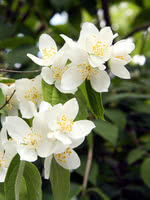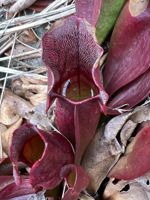Mon-Fri 9am - 5pm Mountain time
Mock Orange vs Purple Pitcher Plant
Philadelphus coronarius
Sarracenia purpurea
NOT AVAILABLE THIS SEASON - MIGHT RETURN
CUSTOM GROW
Mock Orange is an ornamental shrub known for its fragrant, white flowers. The scent is often described as orange-like with a hint of jasmine. Attractive to pollinators, hummingbirds, and humans alike.
Mock Orange is highly versatile, and can be used as an ornamental shrub, either alone or as a hedge. It is well suited for streambank stabilization and riparian zone restoration, due to its ability to grow in low, moist areas as well as those that are high and dry. Lewis Mock Orange also has the capability of being used in soil bioengineering projects such as live staking.
Purple Pitcher Plant is a native carnivorous plant, easily recognized by its purple-tinged, tubular pitchers that capture and digest insects. The nectar along the rim attracts insects to the pitcher, where slippery surfaces and downward-pointing hairs cause them to fall into the fluid below. Once inside, they are broken down, providing nutrients that allow the plant to thrive in nutrient-poor soils.
The plant produces nodding, purple-red flowers held high above the leaves. Interestingly, these blooms are pollinated by the Pitcher Plant Fly (Fletcherimyia fletcheri), whose larvae live in the fluid of the pitchers and feed on some of the trapped insects. It can be found in bogs, fens, and other wetlands. It is well-suited for wetland gardens, restoration, and naturalisation projects.
The Purple Pitcher Plant can be challenging to grow because of its specific requirements. It thrives in consistently moist (but not waterlogged), acidic soil, with a peat-and-sand mix typically recommended. The plant is sensitive to fertilizers, dissolved salts, and chlorinated water. When given the right conditions, full sun will bring out its brightest colors.
The Purple Pitcher Plant is the provincial flower of Newfoundland & Labrador.

